A LS-SVM based Measurement Points Classification Algorithm for Adjacent Targets in WSNs
Abstract
1. Introduction
2. Related Work
3. The Proposed Algorithm
3.1. Algorithm Overview
3.2. EKF algorithm for Target Tracking
3.3. Predicting the Classification Line
| Algorithm 1 Predicting the classification line |
| Input: best classification line and observed centers of targets at time ; Output: predicted classification line and observed centers of targets at moment ; 1: Input the best classification line and observed centers of targets at time as initial parameters, get the reference classification line and predicted targets positions and at moment ; 2: Calculate the intersection point and scaling factor according to the straight line equations; 3: Compute the predicted intersection point on the basis of scaling factor and predicted positions of targets ,; 4: Calculate the normal vector of based on positions of targets at time and ; 5: Obtain the predicted classification line at moment with intersection point and normal vector of ; 6: Calculate the observed centers of targets at time after classifying the sampling points with the predicted classification line, which will be utilized to track targets based on EKF. |
3.4. Training the Best Classification Line
| Algorithm 2 Training the best classification line |
| Input: predicted classification line and observed measure point set at time ; Output: best classification line at moment ; 1: Input the predicted classification line and observed measure point set at time ; 2: Classify the observed measure point set by using the predicted classification line according to Equation (19), which will get the classified sampling point set with the binary class labels ; 3: Substituting into Equation (23) to compute the parameter and b, and finally get the best classification line at moment . |
4. Algorithm Simulation and Validation
4.1. Parameter Selection
4.2. Simulation of Classification Performance
4.3. Simulation of Tracking Performance
5. Experimental Evaluation
5.1. Experimental Implementation
5.2. Experimental Analysis
6. Conclusions and Future Work
Author Contributions
Funding
Conflicts of Interest
References
- Chhaya, L.; Sharma, P.; Bhagwatikar, G.; Kumar, A. Wireless sensor network based smart grid communications: Cyber attacks, intrusion detection system and topology control. Electronics 2017, 6, 5. [Google Scholar] [CrossRef]
- Mois, G.; Folea, S.; Sanislav, T. Analysis of three IoT-based wireless sensors for environmental monitoring. IEEE Trans. Instrum. Meas. 2017, 66, 2056–2064. [Google Scholar] [CrossRef]
- Pau, G.; Salerno, V.M. Wireless sensor networks for smart homes: A fuzzy-based solution for an energy-effective duty cycle. Electronics 2019, 8, 131. [Google Scholar] [CrossRef]
- Tomic, S.; Beko, M.; Dinis, R. 3-D target localization in wireless sensor networks using RSS and AoA measurements. IEEE Trans. Veh. Technol. 2016, 66, 3197–3210. [Google Scholar] [CrossRef]
- ZDeshpande, N.; Grant, E.; Henderson, T.C. Target localization and autonomous navigation using wireless sensor networks—A pseudogradient algorithm approach. IEEE Syst. J. 2013, 8, 93–103. [Google Scholar] [CrossRef]
- Jiang, J.A.; Zheng, X.Y.; Chen, Y.F.; Wang, C.H.; Chen, P.T.; Chuang, C.L.; Chen, C.P. A distributed RSS-based localization using a dynamic circle expanding mechanism. IEEE Sens. J. 2013, 13, 3754–3766. [Google Scholar] [CrossRef]
- Kalman, R.E. A new approach to linear filtering and prediction problems. J. Basic Eng. 1960, 82, 35–45. [Google Scholar] [CrossRef]
- Yang, Y.; Fan, X.; Zhuo, Z.; Wang, S.; Nan, J.; Xu, Y. Amended Kalman filter for maneuvering target tracking. Chin. J. Electron. 2016, 25, 1166–1171. [Google Scholar] [CrossRef]
- Julier, S.J.; Uhlmann, J.K. Unscented filtering and nonlinear estimation. Proc. IEEE 2004, 92, 401–422. [Google Scholar] [CrossRef]
- Bar-Shalom, Y.; Marcus, G. Tracking with measurements of uncertain origin and random arrival times. IEEE Trans. Autom. Control. 1980, 25, 802–807. [Google Scholar] [CrossRef]
- Choi, M.E.; Seo, S.W. Robust multitarget tracking scheme based on Gaussian mixture probability hypothesis density filter. IEEE Trans. Veh. Technol. 2015, 65, 4217–4229. [Google Scholar] [CrossRef]
- Jiang, L.; Singh, S.S.; Yıldırım, S. Bayesian tracking and parameter learning for non-linear multiple target tracking models. IEEE Trans. Signal Process. 2015, 63, 5733–5745. [Google Scholar] [CrossRef]
- Wang, T.; Wang, X.; Zhao, Z.; He, Z.; Xia, T. Measurement data classification optimization based on a novel evolutionary kernel clustering algorithm for multi-target tracking. IEEE Sens. J. 2018, 18, 3722–3733. [Google Scholar] [CrossRef]
- He, X.; Wang, T.; Liu, W.; Luo, T. Measurement data fusion based on optimized weighted least-squares algorithm for multi-target tracking. IEEE Access 2019, 7, 13901–13916. [Google Scholar] [CrossRef]
- Zhang, Z.; Fu, K.; Sun, X.; Ren, W. Multiple target tracking based on multiple hypotheses tracking and modified ensemble Kalman filter in multi-sensor fusion. Sensors 2019, 19, 3118. [Google Scholar] [CrossRef]
- Ahmed, M.N.; Yamany, S.M.; Mohamed, N.; Farag, A.A.; Moriarty, T. A modified fuzzy c-means algorithm for bias field estimation and segmentation of MRI data. IEEE Trans. Med. Imaging 2002, 21, 193–199. [Google Scholar] [CrossRef]
- Kanungo, T.; Mount, D.M.; Netanyahu, N.S.; Piatko, C.D.; Silverman, R.; Wu, A.Y. An efficient k-means clustering algorithm: Analysis and implementation. IEEE Trans. Pattern Anal. Mach. Intell. 2002, 24, 881–892. [Google Scholar] [CrossRef]
- Zhang, S.; Zhao, S.; Sui, Y.; Zhang, L. Single object tracking with fuzzy least squares support vector machine. IEEE Trans. Image Process. 2015, 24, 5723–5738. [Google Scholar] [CrossRef]
- Suykens, J.K.; Lukas, L.; Van Dooren, P.; De Moor, B.; Vandewalle, J. Least squares support vector machine classifiers: A large scale algorithm. In Proceedings of the European Conference on Circuit Theory and Design, ECCTD; Citeseer: Stresa, Italy, 1 September 1999; Volume 99, pp. 839–842. [Google Scholar]
- Schoenecker, S.; Willett, P.; Bar-Shalom, Y. Trackability: Resolvability of two closely-spaced targets. International Society for Optics and Photonics. In Proceedings of the Signal Processing, Sensor/Information Fusion, and Target Recognition XXV, Baltimore, MD, USA, 17–21 April 2016; Volume 9842, p. 984205. [Google Scholar]
- Schoenecker, S.; Willett, P.; Bar-Shalom, Y. Resolution limits for tracking closely spaced targets. IEEE Trans. Aerosp. Electron. Syst. 2018, 54, 2900–2910. [Google Scholar] [CrossRef]
- Li, P.; Ge, H.; Yang, J. Adaptive measurement partitioning algorithm for a Gaussian inverse Wishart PHD filter that tracks closely spaced extended targets. Radioengineering 2017, 26, 573–580. [Google Scholar] [CrossRef]
- Wang, X.; Guo, R.; Jha, N.K.; Wolf, W. Multi-sensor targets data association and track fusion based on novel AWFCM. Int. J. Nonlinear Sci. Numer. Simul. 2009, 10, 811–822. [Google Scholar] [CrossRef]
- Wang, H.; Liu, G.; Zhang, D.; Han, K.; Jiang, M. Clustering based multiple hypothesis multi-target localization. In Proceedings of the 2017 4th International Conference on Information Science and Control Engineering (ICISCE), Changsha, China, 21–23 July 2017; pp. 898–901. [Google Scholar]
- Huang, Y.; Zhang, Y.; Li, N.; Wu, Z.; Chambers, J.A. A novel robust student’st-based Kalman filter. IEEE Trans. Aerosp. Electron. Syst. 2017, 53, 1545–1554. [Google Scholar] [CrossRef]
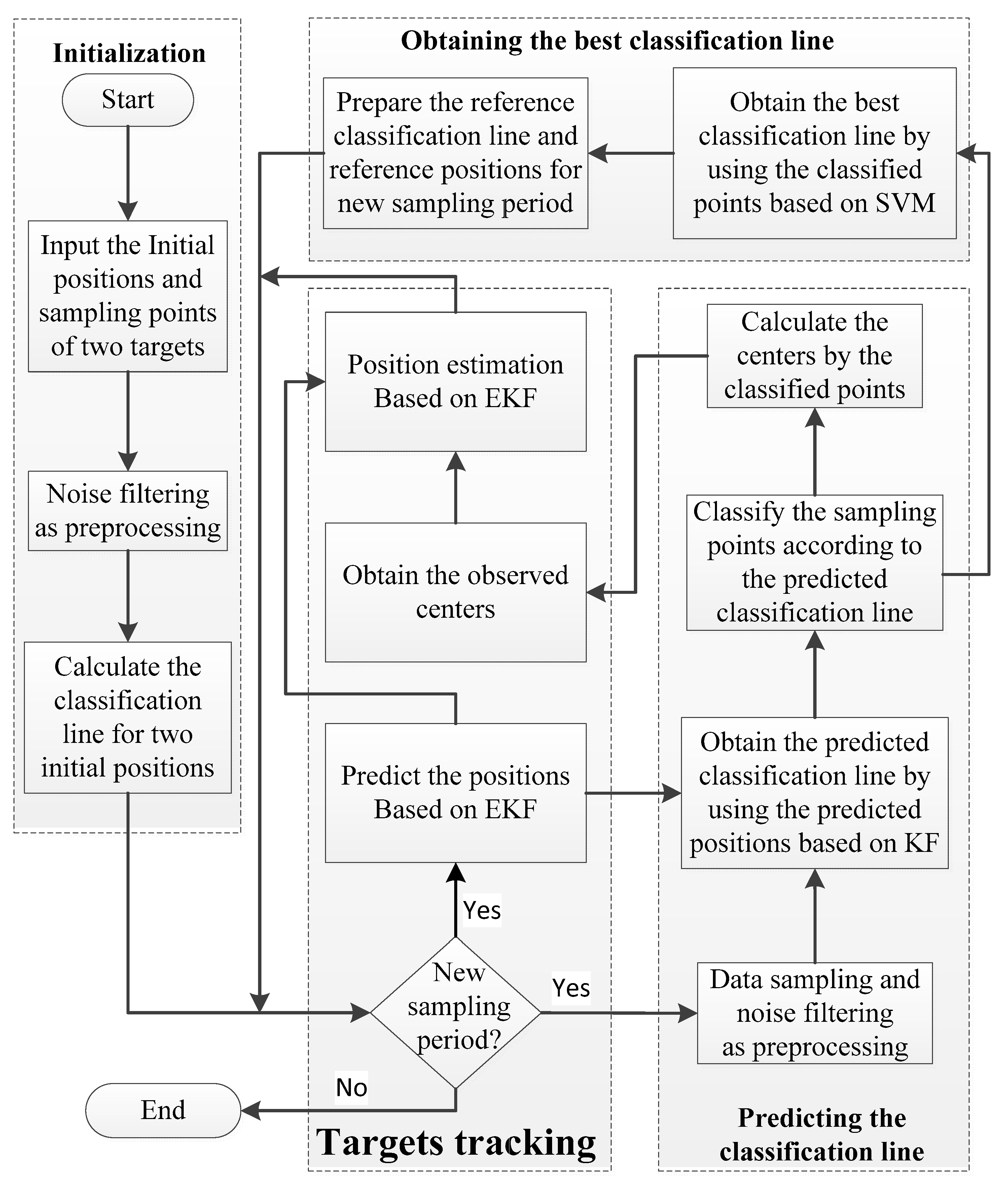

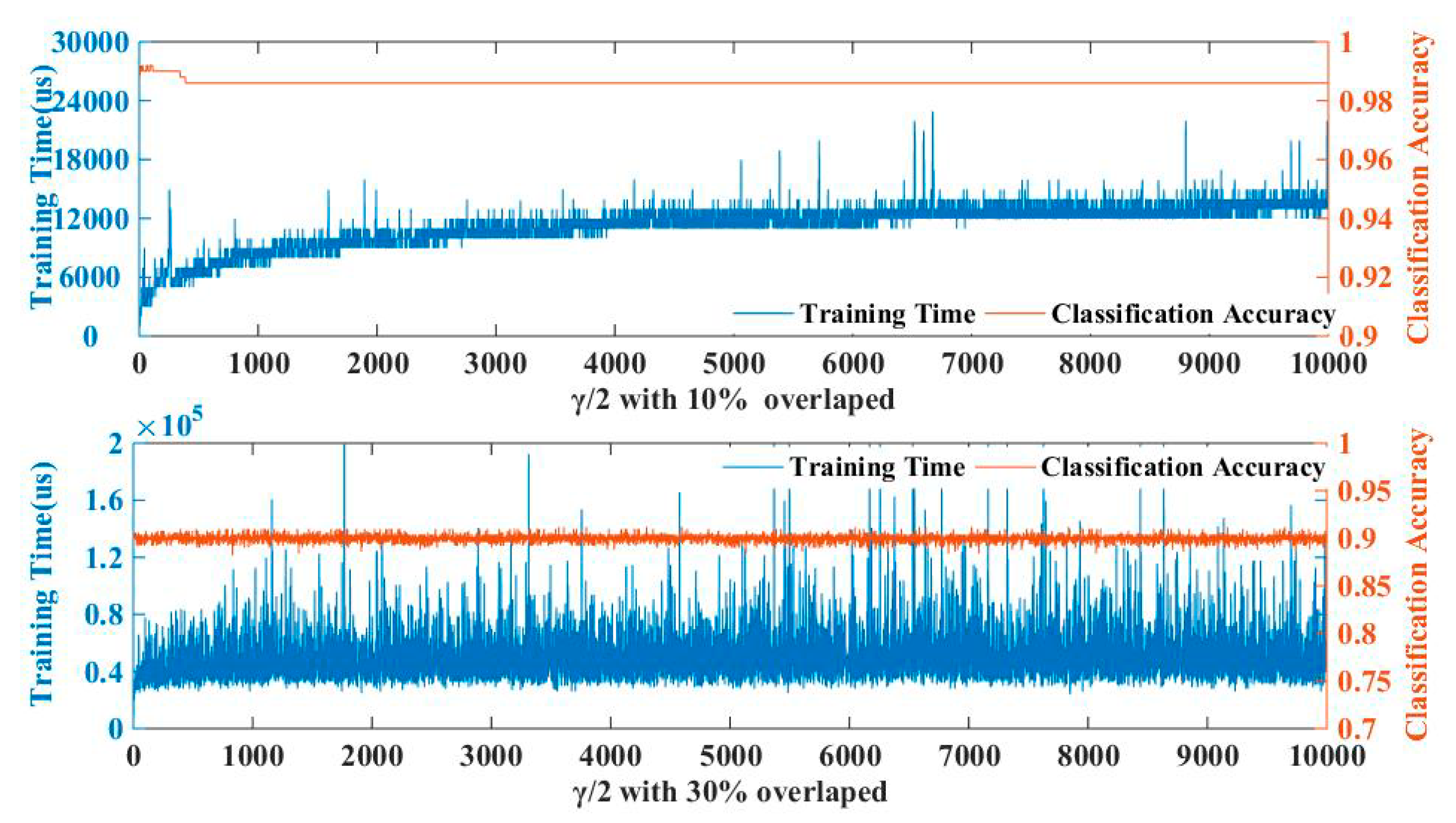

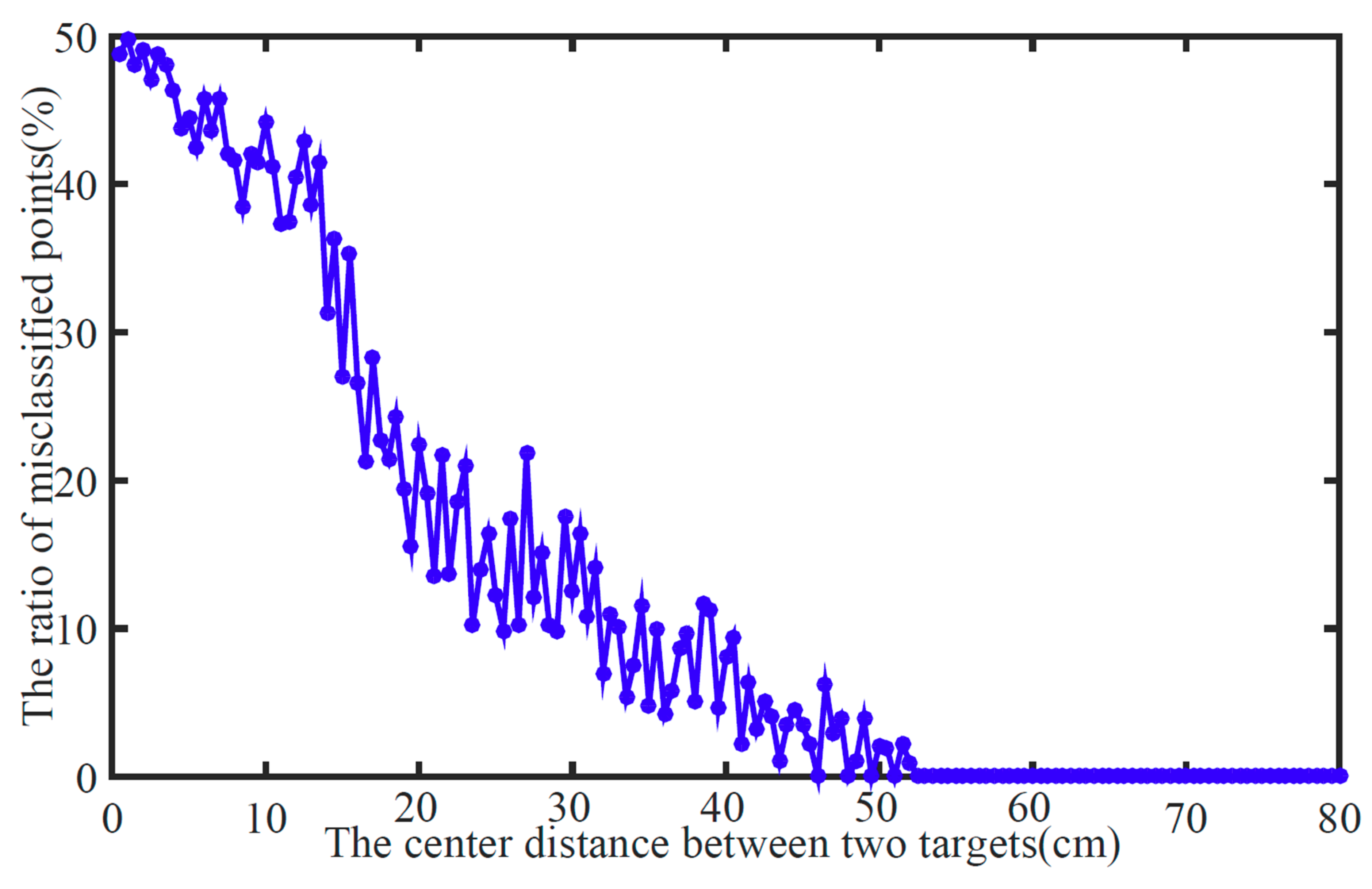
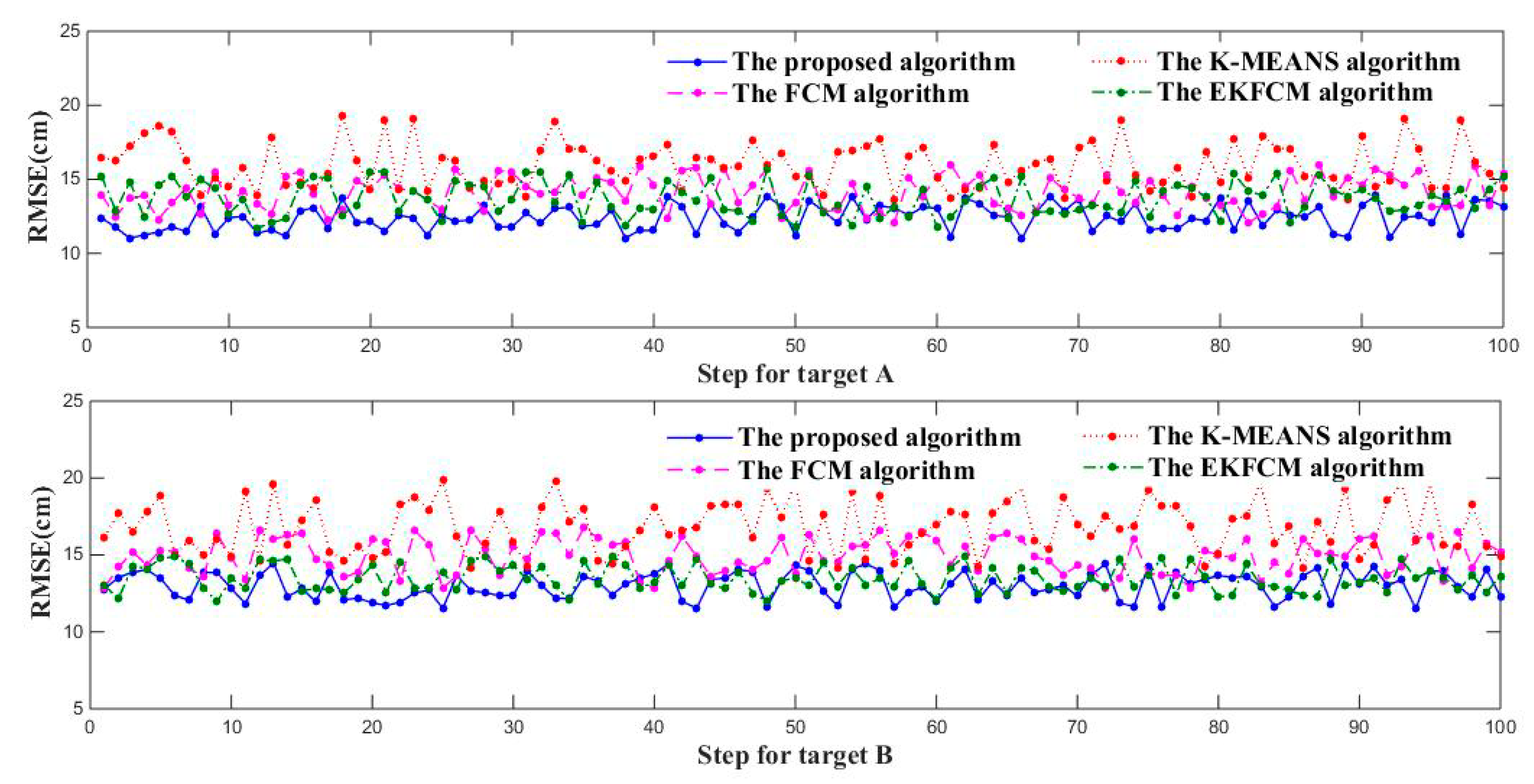



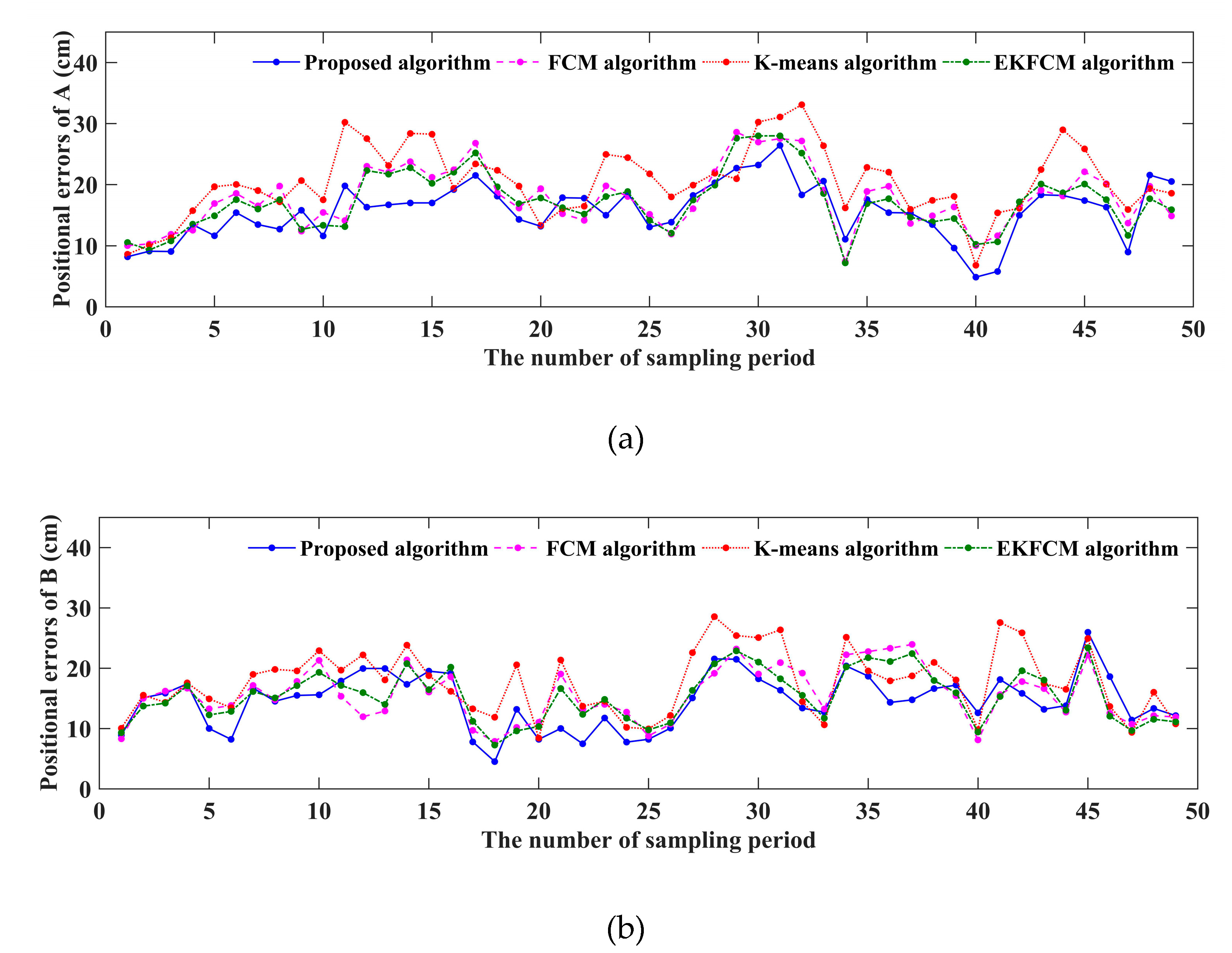

| Target | K-Means | FCM | EKFCM | Proposed Method |
|---|---|---|---|---|
| A (cm) | 15.7163 | 13.7165 | 13.7481 | 12.1711 |
| B (cm) | 15.8078 | 14.1137 | 13.4989 | 12.4182 |
| Improvement rate (%) | 21.99 | 11.65 | 9.75 | - |
| Average Run Time (s) | 0.1534 | 0.1674 | 0.1871 | 0.2162 |
| Target | K-Means | FCM | EKFCM | Proposed Method |
|---|---|---|---|---|
| A | 20.9915 | 19.1967 | 17.8418 | 16.9961 |
| B | 18.2747 | 16.0483 | 15.9778 | 15.4728 |
| Target | K-Means | FCM | EKFCM | Proposed Method |
|---|---|---|---|---|
| A (cm) | 18.8562 | 18.1433 | 17.6606 | 15.6904 |
| B (cm) | 18.9090 | 17.8874 | 17.4856 | 16.1786 |
| Improvement rate (%) | 15.61 | 11.54 | 9.32 | - |
© 2019 by the authors. Licensee MDPI, Basel, Switzerland. This article is an open access article distributed under the terms and conditions of the Creative Commons Attribution (CC BY) license (http://creativecommons.org/licenses/by/4.0/).
Share and Cite
Wang, X.; Zhao, Z.-M.; Wang, T.; Zhang, Z.; Hao, Q.; Li, X.-Y. A LS-SVM based Measurement Points Classification Algorithm for Adjacent Targets in WSNs. Sensors 2019, 19, 5555. https://doi.org/10.3390/s19245555
Wang X, Zhao Z-M, Wang T, Zhang Z, Hao Q, Li X-Y. A LS-SVM based Measurement Points Classification Algorithm for Adjacent Targets in WSNs. Sensors. 2019; 19(24):5555. https://doi.org/10.3390/s19245555
Chicago/Turabian StyleWang, Xiang, Zong-Min Zhao, Tao Wang, Zhun Zhang, Qiang Hao, and Xiao-Ying Li. 2019. "A LS-SVM based Measurement Points Classification Algorithm for Adjacent Targets in WSNs" Sensors 19, no. 24: 5555. https://doi.org/10.3390/s19245555
APA StyleWang, X., Zhao, Z.-M., Wang, T., Zhang, Z., Hao, Q., & Li, X.-Y. (2019). A LS-SVM based Measurement Points Classification Algorithm for Adjacent Targets in WSNs. Sensors, 19(24), 5555. https://doi.org/10.3390/s19245555





